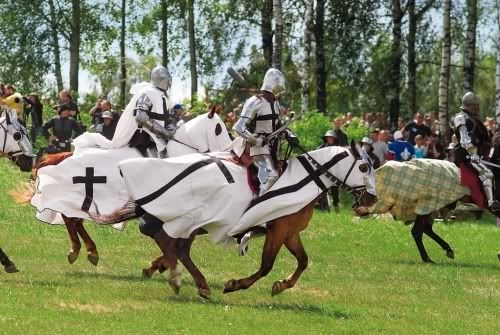Galloglaich
First Post
[ame]http://www.youtube.com/watch?v=Hrcv7kaSUwc[/ame]
I'm about 3/4 the way through watching this film, I had to pause it last night and get to bed but I'll finish watching it tonight. I was a little disappointed at first because I'm used to foreign historical or even fantasy films being a bit more historically accurate. This was not... it seems to be a Russian version of one of those early 80s US fantasy films like Conan or Beastmaster or Krull, it seems to borrow elements from all three. The beginning is almost a direct copy of the first Conan film, (kid in a village, dad making a sword, wasted by demonic bad guy and his goons). The hero has an affinity for animals like beastmaster but in this case it's a bat. Yes that's right, a bat. He has a cute little pet bat which squeaks a lot and crawls around. I haven't seen it do anything else yet.
There are a few girls who are also quite cute, particularly his love interest a slavic princess. The costumes and most of the sets are ridiculous, maybe the same art director as beasmaster (a very similar low budget art department look). Some of the fighting is actually quite decent though, surpirsingly. Seems to be maybe some systema in there or something similar. There is also kind of an interesting take on paganiasm throughout the film, there seem to be very good, very bad, and kind of in between pagans who are neither really good or all that bad.
I kept wavering between turning it off or continuing to watch, but then something would amuse me and I would stick with it a little longer. It seems to have gradually gotten better.
Plusses so far:
Surprisingly decent fighting in some parts
Some beautiful Russian girls
Nice panoramic scenes of Russian countryside
Kinda fun in a goofy way like those old 80's movies
minuses so far:
retarded costumes
dirty medieval caveman look for most people (luckily not the pretty girls though)
retarded sets
I'll add more commentary when I see the rest tonight in case anyone is interested. Anyone else seen it?
G
I'm about 3/4 the way through watching this film, I had to pause it last night and get to bed but I'll finish watching it tonight. I was a little disappointed at first because I'm used to foreign historical or even fantasy films being a bit more historically accurate. This was not... it seems to be a Russian version of one of those early 80s US fantasy films like Conan or Beastmaster or Krull, it seems to borrow elements from all three. The beginning is almost a direct copy of the first Conan film, (kid in a village, dad making a sword, wasted by demonic bad guy and his goons). The hero has an affinity for animals like beastmaster but in this case it's a bat. Yes that's right, a bat. He has a cute little pet bat which squeaks a lot and crawls around. I haven't seen it do anything else yet.
There are a few girls who are also quite cute, particularly his love interest a slavic princess. The costumes and most of the sets are ridiculous, maybe the same art director as beasmaster (a very similar low budget art department look). Some of the fighting is actually quite decent though, surpirsingly. Seems to be maybe some systema in there or something similar. There is also kind of an interesting take on paganiasm throughout the film, there seem to be very good, very bad, and kind of in between pagans who are neither really good or all that bad.
I kept wavering between turning it off or continuing to watch, but then something would amuse me and I would stick with it a little longer. It seems to have gradually gotten better.
Plusses so far:
Surprisingly decent fighting in some parts
Some beautiful Russian girls
Nice panoramic scenes of Russian countryside
Kinda fun in a goofy way like those old 80's movies
minuses so far:
retarded costumes
dirty medieval caveman look for most people (luckily not the pretty girls though)
retarded sets
I'll add more commentary when I see the rest tonight in case anyone is interested. Anyone else seen it?
G
Last edited:








